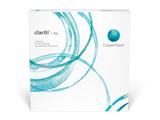
Silicone hydrogel contact lenses have been around for a while now, but more and more often, eye care professionals are making a strong recommendation that patients select this specific lens material. Here’s why.
What Is Silicone Hydrogel?
Ever since soft contact lenses were first developed, researchers sought to create materials that would increase the oxygen permeability to allow for longer hours of wear and help promote better eye health.
If you’re not sure whether your lenses are made of silicone hydrogel, be sure to ask your eye care professional.
What Eye Care Providers Think About Silicone Hydrogel
Research indicates that 77% of all contact lens fits use silicone hydrogel materials.1 Among patients who wear frequent replacement contact lenses that percentage is even higher—82% of frequent replacement contact lenses fit are silicone hydrogel materials.1
The reason for this is simple: our bodies rely on oxygen, and the eyes are no exception. Eye care professionals prefer silicone hydrogel over regular hydrogel because they want patients to wear contact lenses that can deliver more oxygen to the cornea than hydrogel contact lenses can2.
Patients benefit from a material that copes well with the long hours of wear that a busy lifestyle may demand. In fact, eye care professionals say that 70% of the time, the reason they suggest a switch to silicone hydrogel is because patients had issues with their previous lenses.3
Even if you wear a daily disposable lens, material matters. Nearly nine in ten eye care providers agree, people who wear 1 day lenses should be in a silicone hydrogel material.4
In short, silicone hydrogels are highly breathable and healthy1 soft contact lens materials, with a high oxygen transmissibility that helps keep eyes white and bright.1,5
1 Morgan P, Woods C, Tranoudis IG, et al. International Contact Lens Prescribing in 2019. Contact Lens Spectrum. 2020;35(January 2020):26-32.
2 Survey results of n=300 ECPs in US, UK and Japan - Feb 2018.
3 Basis. Migration from FRP to DD. Surveys conducted online in Q1 2019 in Europe (France, Germany, Italy, Spain) and the US. 75 eye care professionals (ECPs) in each European country, with French sample weighted to 75; 150 ECPs in the US, plus 500 consumers in each of Germany, Italy, Spain and the US who had switched from FRP to DD in the last 6 months, or who were open to using DD in future. CVI data on file 2019
4 Orsborn G, Dumbleton K. Eye care professionals’ perceptions of the benefits of daily disposable silicone hydrogel contact lenses. Cont Lens Anterior Eye, 101016/jclae201902012. 2019.
5 CVI data on file 2014. Double-masked, randomized, controlled crossover trial. N=30. clariti® 1 day significantly whiter eyes (less limbal hyperemia) than 1-DAY ACUVUE® MOIST.
1 With higher oxygen permeability than hydrogel materials, silicone hydrogel contact lenses minimize or eliminate hypoxia-related signs and symptoms during lens wear.





